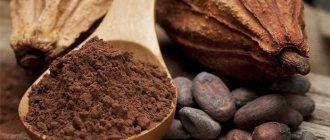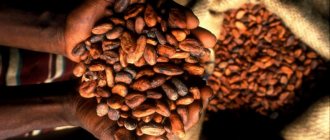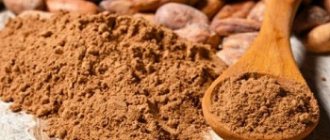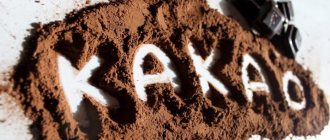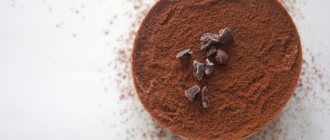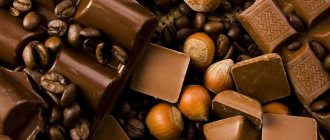Myth 1. The most “correct” cocoa comes from Soviet cocoa powder
Fiction. What is cocoa powder anyway?
It is a by-product of cocoa butter production. Cocoa mass and cocoa butter are obtained from cocoa beans. After processing (extraction) of cocoa butter - a valuable product used in cooking and chocolate production - pure cocoa bean cellulose remains with a small residual fat content of about 10%. This is cocoa powder. The best cocoa comes from cocoa mass or dark chocolate, not from powder. This drink has greater density and a more expressive taste, since cocoa butter is the carrier of flavor shades. To make a drink from grated cocoa or dark chocolate, you need to melt the chocolate in milk. For a balanced taste, you can add sugar to the cocoa liquor during preparation.
What is cocoa liquor
Pre-roasted and ground cocoa beans form a homogeneous semi-liquid mass called cocoa liquor. This is a semi-finished product for making cocoa butter and powder, as well as a base for chocolate without sweet additives, made in the form of blocks. Preliminary cleaning from foreign impurities guarantees high quality of delicate cocoa mass.
Myth 2. You can’t make a cocoa drink without milk and sugar.
Fiction. This idea is based on the misconception of what cocoa should be - simply brewing the powder with milk and adding sugar to taste. But we add milk to the powder, practically, out of necessity, including for density and richness. On water, the taste of a drink made from cocoa powder will be completely empty. If you make a drink from grated cocoa, it is not necessary to add milk, since the cocoa itself has enough fat content.
But without sugar, such a drink will really be “for everyone.” Many may find it too bitter. Cocoa itself is a bitter product. Cocoa beans acquire bitterness as a result of fermentation, as well as the chocolate flavor that we love cocoa for. Sugar softens the bitterness and pleases our receptors, so there is no reason to refuse it in the drink.
The benefits and harms of grated cocoa
The obvious advantages of ready-made grated cocoa include the following:
- Rich natural composition with antioxidant, anti-allergenic and regenerating properties. Cocoa has a beneficial effect on the heart muscle, improves the condition of blood vessels, reduces the risk of thrombosis and increased blood pressure. Normalizes metabolism, maintains normal functioning of the thyroid gland, restores muscle performance and treats skin diseases.
- Relatively low cost compared to other forms of the product - cocoa butter.
- Possibility of making dark, milk and white chocolate.
- High taste qualities in the manufacture of confectionery products in industrial production and at home.
We can also highlight the disadvantages of the product:
- The need for additional sterilization to destroy heat-resistant microorganisms that do not die during the frying process.
- Possibility of sour or moldy taste in batches of cocoa beans of Malaysian and South American origin, which cannot be corrected during processing and dearomatization in Moscow.
Myth 3. Cocoa is a drink for children
50/50. This stereotype is generated by advertising, presenting a mixture of cocoa powder and sugar as something extremely tasty and healthy for children. But I would say that cocoa is more of a drink for gourmets who are interested in the taste of wine, cheese, coffee, tea... This is research, the development of the organoleptic apparatus. At the same time, of course, cocoa is great for children, since it does not contain caffeine. Although there is theobromine, a similar chemical compound is an energy booster that stimulates the nervous system. It just works less intensely.
What are the benefits of cocoa powder?
Below is more information about the nutritional benefits of cocoa powder:
1. May help reduce inflammation and oxidative stress. Cocoa is among the main sources of flavonoids and other antioxidants in all foods. Flavonoids have been found to have powerful antioxidant and anti-inflammatory effects. Cocoa polyphenols have also been shown to modulate the gut microbiota, leading to the growth of bacteria in the gut that trigger anti-inflammatory pathways.
Myth 4. People drink cocoa only in the morning.
Fiction. This myth is probably related to the stereotypes about coffee in Italy. It is believed that Italians drink coffee and milk drinks - cappuccino or latte - only before lunch. Indeed, if lactose is poorly absorbed, it is better to drink cocoa with milk in the first half of the day. However, even in this case, you can replace the milk with vegetable milk or make a cocoa shot with water, then you can safely drink it at any time of the day. In addition, cocoa invigorates less than coffee, so you can treat yourself to a cup of this drink even after dinner.
The same applies to the belief that cocoa is exclusively a winter drink. Indeed, the popularity of cocoa grows with the onset of cold weather. The reason for this is simple: it is a warm, enveloping and very nutritious drink that helps you warm up and feel full after a winter walk. However, cocoa is a self-sufficient drink; it suits any weather and any mood.
History of chocolate
The history of chocolate goes back more than three thousand years. Cocoa fruits were known to the Olmec civilization - American Indians who lived a thousand years BC.
It has been noticed that among pagan peoples the object of worship is everything unusual. Over the centuries, many Indian cultures have changed, but the ancient inhabitants of America always had a reverent attitude towards cocoa. The Mayan tribes believed in the god of cocoa and drank chocolate during rituals as a sacred drink. The Aztecs called cocoa fruits the food of the gods and believed that they gave spiritual insight.
Initially, chocolate was consumed only as a drink. From the language of the Mexican Indians, the word “chocolate”, or rather “chocoatl”, is translated as “bitter water” or “water and foam”. The drink was quite viscous, bitter, and was prepared with spices and aromatic herbs. This is how the first European, Christopher Columbus, recognized him, delivering cocoa fruits, among other wonders, to the Spanish monarch. However, for a whole century the drink remained in oblivion. Chocolate gifts
Fernando Cortes, the viceroy of the king in New Spain, really tried it. While conquering part of Mexico, he appreciated the invigorating energy of the Indian drink. In addition, cocoa fruits were used by the local population as money. Having learned about this, Cortez became the richest owner of cocoa plantations.
At the suggestion of Cortes, the drink became known to the Spanish monarch. At the same time, chocolate was so popular with the court that they began to drink it in all noble houses. Mere mortals could not try the drink: it was so expensive that one could buy a good slave for a hundred cocoa grains. However, two hundred years later, chocolate houses opened in almost every European city and were loved along with coffee shops. Chocolate was served with hot cross buns and other sweets. They drank it calmly and leisurely, enjoying the tart aroma and unusual taste.
The 19th century was revolutionary in chocolate production. In 1828, engineer Conrad van Houten invented and patented a hydraulic press with which oil was extracted from cocoa beans. In 1879, after eight years of experimentation, the Swiss Daniel Peter introduced solid milk chocolate to the market for the first time. In the same year, inventor Rudolf Lindt from Bern, having made an original device, began producing fondat chocolate, which melted in the mouth. This chocolate was such a success that twenty years later the Zurich confectioner Rudolf Sprüngli paid 1.5 million francs for Lindt’s invention, with which one could buy 435 kg of gold. With the development of civilization, the process of producing chocolate has become cheaper, and chocolate itself has become more accessible. However, in parallel with the mass culture of consumption, an elite culture was born in Europe, for wealthy connoisseurs.
Myth 7. Cocoa is great for depression
50/50. Chocolate is believed to lift your spirits and even help with depression. This myth exists because chocolate is rich in tryptophan. This substance is involved in the synthesis of serotonin, a hormone that improves mood. However, tryptophan from chocolate does not affect serotonin levels. Nevertheless, chocolate still affects the mood, since we should not forget that it is not for nothing that there is a concept of “life in chocolate.” Due to its high fat and carbohydrate content, chocolate is perceived by the body as an appetizing food and stimulates the release of dopamine in the nucleus accumbens of the brain, which is also called the “pleasure center.” So a cup of cocoa or a couple of pieces of chocolate will really lift your spirits.
What is cocoa butter?
Cocoa butter is a vegetable fat obtained from grated cocoa by pressing.
In turn, cocoa liquor is ground nibs from the fruits of the cocoa tree. Cocoa butter is the fatty base for the production of chocolate and other confectionery products. Cocoa butter is whitish-yellow in color, has virtually no odor, and is hard and brittle at room temperature. There are two types of cocoa butter: natural and deodorized (it undergoes additional processing).
As a rule, deodorized cocoa butter is used to produce chocolate. The deodorization process solves the problem of depersonalizing the taste and smell of oil. The essence of deodorization comes down to purifying oil using high temperature, vacuum and steam for distillation. After this treatment, saturated hydrocarbons, acids, aldehydes, pesticides, ketones and natural essential oils are removed from cocoa butter. In general, everything that can be removed is removed, so there is no need to even talk about the benefits of such oil. When producing chocolate using non-deodorized cocoa butter, chocolate acquires a special, specific aroma and taste, it retains most of the acids and essential oils, and it seems that one can conclude that such oil is healthy.
Let's look at the chemical composition of cocoa butter and compare it with other products.
The chemical composition of cocoa butter includes two- and three-acid triglycerides mixed with fatty acids:
- Oleic up to 43% (in hazelnut oil 70-80%);
- Stearic up to 34% (in lamb fat up to 30%);
- Lauric and palmitic up to 25% (in palm kernel oil 47-51%, butter 25%);
- Linoleic 2% (in sunflower oil 46-60%);
- Peanut, only traces present (found in peanut butter).
We can absolutely say that even with the presence of vital acids in cocoa butter, there is no deficiency in the daily human diet, because their consumption is compensated from other products of the daily diet.
Myth 8. Cocoa tastes like chocolate.
50/50. This is true, because chocolate is made from cocoa beans. However, all cocoa in the world is divided into two categories: ordinary (“ordinary” cocoa beans) and fino de aroma - beans with a bright, complex taste and aroma. There are only 5-8% of the world's cocoa bean reserves! The taste of cocoa is influenced by genetic variety, growing conditions, quality of collection, fermentation and drying. As with coffee, there are more acidic varieties and milder ones. In the taste of cocoa, depending on the variety, you can find red berries and tropical fruits, nuts, butter, dried fruits, tobacco and spices. It’s worth trying a fino de aroma chocolate drink to feel the difference. This cocoa mass in discs can be purchased in specialized online stores. The cost of 1 kg is approximately 1000 rubles. and higher.
Cocoa fino de aroma is a whole world of tastes and aromas: fruits, nuts, berries, creamy caramel shades. From grated cocoa and dark chocolate you can make cocoa, hot chocolate, various desserts and baked goods, just like with regular chocolate, but much tastier and healthier (less sugar content).
How to use cocoa powder?
Cocoa powder adds a rich chocolate flavor to any dish it is added to. This can include both sweet and savory foods, such as baked goods and chili.
Here are some uses for cocoa powder:
- Fudge
- Flourless chocolate cake and brownies
- Chocolate truffles
- Cookies, bread and muffins
- Desserts such as mousses, puddings and ice cream.
- Energy balls
- Smoothie
- Drinks such as hot chocolate or espresso.
- Mole sauce
- Chile
- Marinades for meat
When shopping for cocoa products, ideally choose ones that are certified organic and sustainably produced. This reduces the risk of consuming pesticides and other chemicals that may be added during the growing and production process.
How much cocoa should you consume? Evidence suggests that it may be beneficial to regularly include 30g of high-flavanol cocoa powder or 0.5 to 30g of dark chocolate in your diet to maintain overall health.
If you consume sweetened cocoa products, watch your portion sizes as they may be high in calories.
Can you replace natural sugar-free cocoa powder with Dutch cocoa powder? They can be substitutes for each other, however you will need to adjust the type of alkalizing ingredients you use with them to ensure the flavor and recipe are right.
Substitute Dutch powder for the natural powder, adding about 1/8 teaspoon of cream of tartar, white vinegar, or lemon juice for every three tablespoons of natural cocoa powder, which will help slightly adjust its pH and flavor.
Store the powder in an airtight container in a cool, dark, dry place, but do not put it in the refrigerator or freezer as this will affect its texture.
Myth 9. Cocoa beans only grow in Mexico
Fiction. The birthplace of cocoa is the Amazon basin. Ecuador, Peru, Colombia - the first cocoa trees appeared there, then they spread throughout South America. The Mayans and Aztecs carried cocoa north to Mexico and other Central American countries. The beans later found their way to Africa, and now African countries such as Ghana, Cote D'Ivoire and Cameroon are the world's leading cocoa producers. Now coffee is also growing in Asia - in Indonesia and Vietnam. Cocoa grows in almost all subequatorial countries lying between 20° north and 20° south latitude.
BONUS: Video recipe for making orange cocoa from gastronom.ru
Chocolate
A high-tech product, the creation of which is impossible without controlling powerful machines and the finest physical and chemical processes.
The quality and taste of chocolate depends primarily on the type of cocoa beans. The cocoa tree, an evergreen woody plant, has the botanical name Theobroma cacao. "Theobroma" means "food of the gods" in Latin. The hard fruits of this tree look like small melons. Each fruit contains from 20 to 40 seeds arranged in rows. They are called cocoa beans, although they have nothing to do with real beans and legumes. Top five cocoa producing countries: Cote d'Ivoire, Ghana, Indonesia, Nigeria, Brazil. Then come the countries of Latin America (Colombia, Venezuela), the countries of the Caribbean (the leader is Ecuador). Chocolate Turning cocoa beans into chocolate is a complex process in which ingredients, time and temperature play a crucial role. By varying these three parameters, a wide variety of unique recipes can be created.
How to test real chocolate: we conduct experiments at home
If the composition is unknown and the appearance is questionable, you can conduct a couple of simple experiments. They are especially interesting for children (but be careful with fire).
Here are some visual ways to check the naturalness of chocolate:
- Take a small piece and hold it in your fist for 20 seconds. It should melt. If this does not happen, the cocoa butter was probably replaced with something else. The melting temperature of a chocolate bar is +32°C.
- Dip a piece into a glass of milk. If it sinks, it’s natural; if it floats, there are additives.
- Freeze a piece. If it turns white, it's real.
- Dark chocolate can be brought to the fire. It should melt, not burn. If the bar caught fire, most likely the cocoa liquor was replaced with powder.
Can pregnant women drink cocoa?
Expectant mothers, no less than others, strive to enjoy cocoa and its derivatives - hot and regular chocolate. But what about contraindications? Can a pregnant woman drink this drink? We already know about the beneficial properties. It is worth adding that the drug reduces the level of bad cholesterol, enhances creative and mental activity, and normalizes blood pressure. All this is very important for a woman’s body in an “interesting” position.
- But there is another component - folic acid, an important element for the formation of the neural tube and the prevention of pathological defects in the embryo.
- Also, during pregnancy, a woman is subject to hormonal changes, which causes her mood to deteriorate, drowsiness, and tearfulness. Phenylephylamine, included in the list of substances in the drink, invigorates, pleases, and calms. But still, can a pregnant woman drink cocoa? Despite a number of positive aspects, doctors still cannot give a definite answer.
There is a golden rule - everything is good in moderation! Yes, and you can’t forbid a lady what she is accustomed to consuming throughout her life before pregnancy.
Important: cocoa can cause side effects due to individual intolerance.
- Cocoa is a product with strong allergenic properties.
- Despite the fact that it contains calcium, the drink can also wash this element out of the body.
- Caffeine can lead to a narrowing of the walls of blood vessels and cause uterine tone, which often leads to a lack of oxygen for the baby and miscarriage.
- It is not recommended to take the drug for people with high blood pressure.
So, to drink or not to drink - the answer is simple. Sometimes a small cup is unlikely to lead to negative consequences (except for allergies). Therefore, if you really want to, allow yourself to enjoy cocoa, but only occasionally.
Live cocoa
It is true that cocoa grows on wild trees in natural tropical forests. There are not enough common herbicides and herbicides. These beans are also often called sacred cocoa. It is being undermined by a new set of corrupt authorities in order to make the products extremely valuable.
Cocoa products are in demand all over the world. It is important to recognize the reality of life without them. We hope that this article will help you understand a little better the main types of cocoa beans and related ones, including cocoa butter.
How to cook cocoa correctly
First, you should study a number of subtleties that will make the drink truly divine and healthy. So:
- You need to cook only from fresh powder.
- When purchasing, you should carefully study the product label and choose only a quality product.
- Buy cocoa only from trusted manufacturers.
- You should not save money - a quality drink cannot be cheap.
- Don't put too much sugar in the drink.
Recipe on water. Everything is simple here. You need to dissolve a couple of spoons of cocoa in hot water (per 1 glass), add 2 spoons of sugar. Cream or milk is added if desired.
Recipe with milk. Mix 2 teaspoons with the same amount of granulated sugar and pour into a container. In a separate bowl, boil the milk and pour it into the mixture. Mix thoroughly and bring to a boil. Remove from heat, cool slightly and pour into cups. As a snack, you can put marshmallows, sweet pastries, cakes or pastries on the table.
Well, so we studied another useful product called cocoa. Now we know about its valuable properties and have become familiar with the contraindications for use. But, as they say, everything is possible in moderation. After all, just the name alone plunges us into memories of this drink. How we love to wrap ourselves in a warm blanket on cold days and drink hot cocoa while snacking on delicious cookies or marshmallows. Positive moments, moments of joy immediately arise in your thoughts. The hand reaches out to a book that we once read in childhood and we rejoice in meeting the heroes of our favorite works. And immediately a pleasant and aromatic warmth spreads throughout our body, thanks to which we calm down, feel complete comfort and harmony with the world around us. Drink cocoa and be healthy!
Is it possible for children to have cocoa?
Many of us are familiar with the smell of this drink from childhood. Mixed with milk, it brought true pleasure and gave joy. Thanks to the drink, the baby receives valuable phosphorus, zinc, vitamins and other valuable components.
- Polyunsaturated fats are involved in the formation of cell membranes.
- Cocoa is very useful for obesity, since one cup can replace an entire meal and satisfy hunger.
- The substance theobramine inhibits the dry cough reflex, which is important for colds and infectious diseases of the respiratory tract.
- Drinking cocoa in the morning improves mental abilities and allows you to get only good grades at school and cope with stress more easily.
- If a child participates in a sports section, then the drink will help him restore strength, increase performance and endurance.
When you can give your baby this drink - start no earlier than 3 years. Considering that cocoa is a powerful allergen, a tiny portion is needed, literally half a sip. Give the treat in the morning and observe the body’s reaction. If redness, tearfulness, itching, swelling, or rash occurs, stop taking it immediately and give an antihistamine. And see a doctor.
If the body accepts the drink normally, gradually increase the dose, but do not exceed 50 grams until 5 years of age and no more than 2 times a week.
Alkalized cocoa
Cocoa was given this name due to its rich color. It turns out quite dark. It is also obtained from cocoa products when they are processed using alkaline salts. Alkalized cocoa is better soluble in water and has less acidity.
This product is used to prepare high-quality dessert products. If you add it to the dough, it will not spread at high temperatures and will retain its rich color. Also, it is alkalized cocoa that is used to prepare “Dutch cocoa”, which does not need to be boiled.
